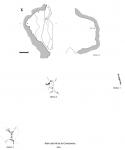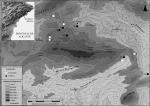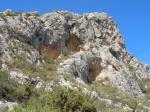Summary (English)
Research (2010-2011)
The shelter caves of La Condomina are located on one of the rocky foothills of the Sierra de Aitana, to the north of its geodesic vertex and to the south of the municipality of Confrides, 950 meters above sea level. More specifically, the shelters are situated on the highest point of a limestone spur of the Eocene, where we can observe the opening of three shelters. However, paintings can be found only in the uppermost shelter, which measures 5 m in length, 4 m in height, and 2 m at its deepest point, and has no sedimentation. There is a high level of visibility from the site.
This shelter boasts a total of four motifs spread out over two different panels. The typological variability is low, given that three of the figures are anthropomorphs: stick figures in the form of a double “Y” and that the remaining motif is a bar. From a typological standpoint, the aforementioned anthropomorphs belong to the same group. Nevertheless, the marked variability in the way of representing the features of each figure should be appreciated. Figure 2 best fits the prototype of an anthropomorph in double “Y”; it is made up of a relatively elongated trunk with the superior and inferior extremities open on upward and downward angles, respectively. Throughout the province of Alicante, these types of figures have been documented in numerous shelters containing schematic and macroschematic art, though some variables do exist, such as forms exhibiting a clearly marked head or extremities that were comparatively more or less open.
Figure 3 undoubtedly stands out more than the others. It is another anthropomorph in a double “Y” form that has its arms and legs on an angle and a clearly marked head. The lower extremities adapt to the curvature of the rock, which causes them to bend slightly at the end; however, the greatest distinctive feature is the presence of lines at the end of the arms, as if they were fingers. This characteristic has only been documented in macroschematic art and in another schematic anthropomorphic figure from the Penya Roja, though it represents a different typology. To this day there are no other known motifs of this kind in the Sierra de Aitana.
Figure 1 has been recorded as a sole, vertical bar. This is the most abundant type of motif in shelters with schematic rock art in Alicante, and it almost always is associated with other bars or with other types of motifs. It is common to find bars with figures in double “Y” in the shelters.
(translation by Emily Marie Polacek)
- Francisco Javier Molina Hernández y Virginia Barciela González
Director
- Virginia Barciela González y Francisco Javier Molina Hernández (Universidad de Alicante)
Team
Research Body
- Colegio Oficial de Doctores y Licenciados en Filosofía y Letras y en Ciencias de Alicante - Sección de Arqueología
- Universidad de Alicante
Funding Body
- Dirección General de Patrimonio Cultural. Generalitat Valenciana






![Download [PDF]](/excavation/skins/fasti/images/results/download_sml.png)

